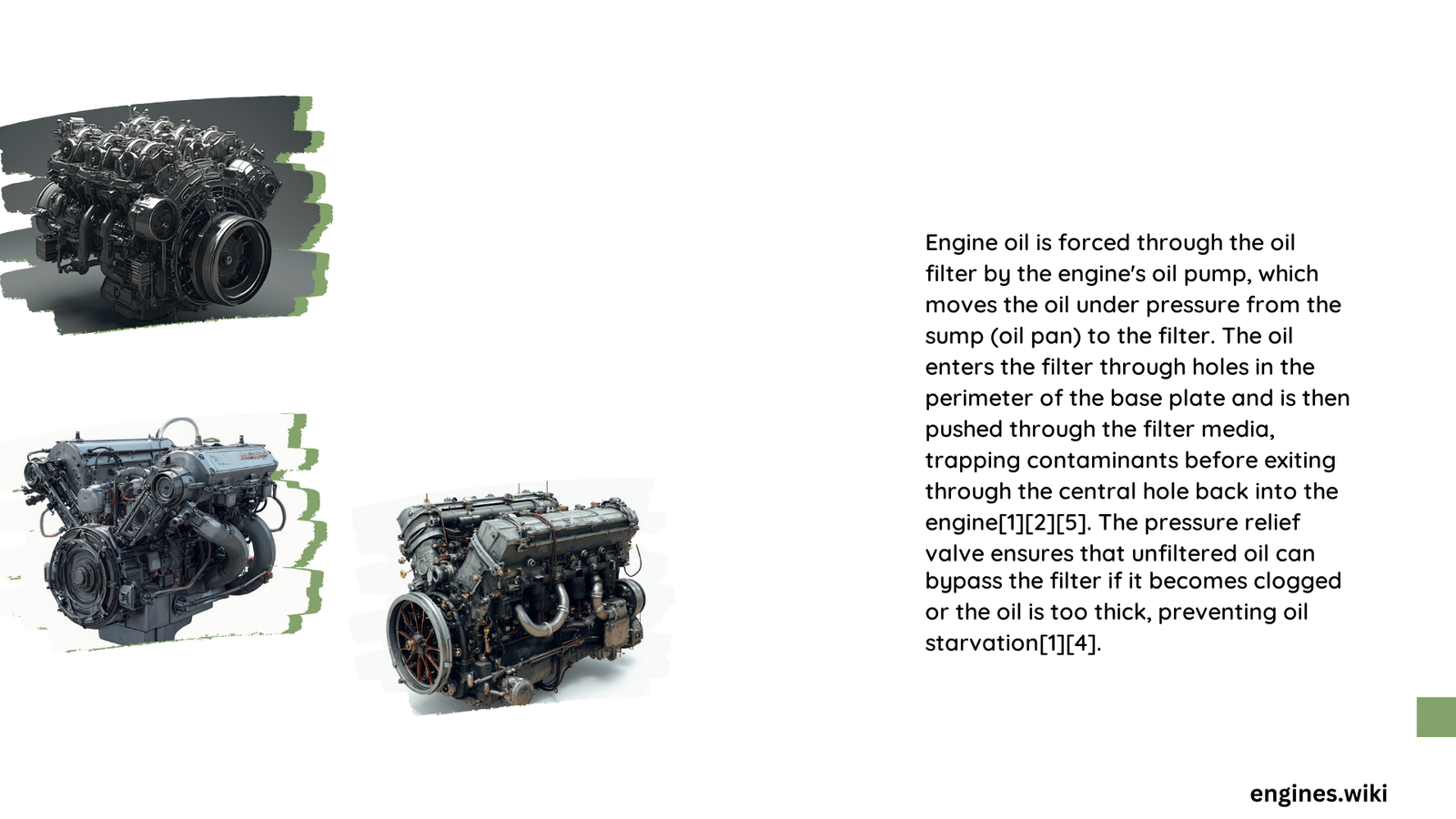Engine oil circulation is crucial for maintaining the health and performance of your vehicle’s engine. The oil filter plays a vital role in this process, removing contaminants and ensuring clean oil reaches critical engine components. But what exactly forces engine oil through the oil filter? This comprehensive guide explores the mechanics behind oil circulation, focusing on the forces that drive oil through the filtration system, the components involved, and the challenges that can arise in this process.
What is the Primary Force Behind Oil Circulation?
The heart of the oil circulation system is the oil pump. This mechanical device generates the pressure necessary to move oil throughout the engine, including through the oil filter. Here’s a breakdown of how the oil pump creates this force:
- Pressure Generation: The oil pump typically produces pressure ranging from 30 to 80 PSI (pounds per square inch), depending on the engine design and operating conditions.
- Flow Rate: The pump moves oil at a specific flow rate, often measured in gallons per minute (GPM) or liters per minute (L/min).
- Pump Types: Common oil pump designs include gear pumps, rotor pumps, and vane pumps, each with its own method of creating oil pressure and flow.
How Does Oil Pressure Affect Filtration?

Oil pressure plays a crucial role in forcing oil through the filter. Here’s how it works:
- Pressure Differential: As oil enters the filter, it encounters resistance from the filter media. This creates a pressure differential between the inlet and outlet sides of the filter.
- Flow Through Media: The pressure forces oil through the tiny pores in the filter media, trapping contaminants while allowing clean oil to pass through.
- Pressure Drop: The resistance of the filter media causes a slight drop in oil pressure. Most engines are designed to accommodate this pressure drop while maintaining adequate oil flow.
| Component | Function | Typical Pressure Range |
|---|---|---|
| Oil Pump | Generates pressure | 30-80 PSI |
| Oil Filter | Filters contaminants | 10-15 PSI pressure drop |
| Bypass Valve | Allows oil flow if filter clogs | Opens at 10-15 PSI differential |
What Role Does the Bypass Valve Play?
The bypass valve is a critical safety feature in the oil filtration system:
- Purpose: It prevents oil starvation if the filter becomes clogged or if oil is too thick to flow easily through the filter (e.g., in very cold conditions).
- Operation: The valve opens when the pressure differential across the filter exceeds a certain threshold, typically 10-15 PSI.
- Oil Flow: When open, it allows oil to bypass the filter entirely, ensuring continued lubrication of engine components.
How Do Filter Components Contribute to Oil Flow?
Several components of the oil filter work together to manage oil flow:
- Threaded Plate:
- Controls oil entry into the filter canister
-
Engineered hole sizes and slope grades regulate flow rate
-
Filter Media:
- Captures contaminants while allowing oil to pass
-
Different media types offer varying filtration efficiencies (e.g., capturing particles 5 microns or larger)
-
Gasket and Grommet:
- Gasket ensures a tight seal between filter and engine
- Grommet acts as a spacer and helps seal the main chamber
What Challenges Can Affect Oil Flow Through the Filter?
Several factors can impact the flow of oil through the filter:
- Oil Viscosity: Thicker oil (due to cold temperatures or degradation) increases pressure drop across the filter.
- Filter Clogging: As the filter captures contaminants, it can become clogged, restricting oil flow.
- Pump Wear: A worn oil pump may not generate sufficient pressure to force oil through the filter effectively.
- System Leaks: Leaks in the oil system can reduce overall pressure, affecting flow through the filter.
How Does Oil Flow Impact Engine Performance?
Proper oil flow through the filter is crucial for engine health:
- Lubrication: Ensures moving parts receive clean, well-lubricated oil to reduce friction and wear.
- Cooling: Oil helps dissipate heat from engine components.
- Contaminant Removal: Effective filtration prevents abrasive particles from damaging engine parts.
- Pressure Maintenance: Adequate oil pressure is necessary for proper engine function, including hydraulic systems like variable valve timing.
What Are the Consequences of Inadequate Oil Flow?
If oil doesn’t flow properly through the filter, several issues can arise:
- Increased engine wear due to inadequate lubrication
- Higher operating temperatures leading to potential engine damage
- Accumulation of contaminants in the engine oil, causing accelerated wear
- Reduced engine performance and efficiency
- In extreme cases, complete engine failure
By understanding the forces that drive oil through the filter and the components involved, you can better appreciate the importance of regular oil and filter changes. This knowledge can help you maintain your engine’s health, ensuring optimal performance and longevity.
References:
1. https://luberfiner.com/lfu2/
2. https://en.wikipedia.org/wiki/Oil_filter
3. https://www.ramonatire.com/important-role-of-oil-filters-why-they-are-crucial-for-engine-health/
4. https://www.enginelabs.com/engine-tech/oiling-system-tech/oil-pressure-how-much-is-enough/
